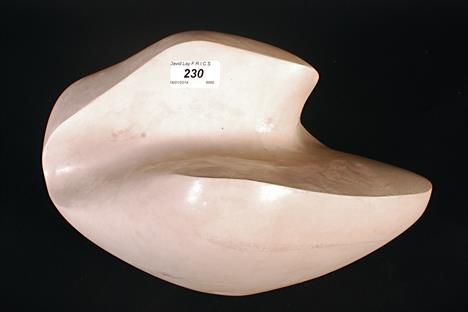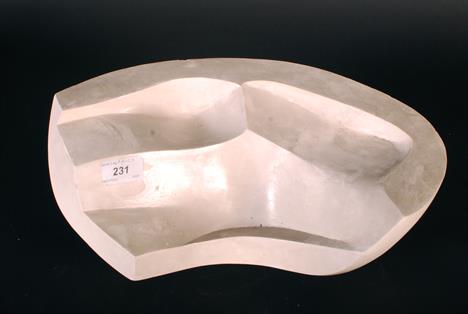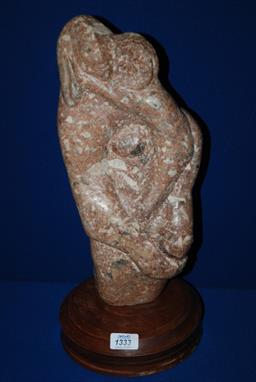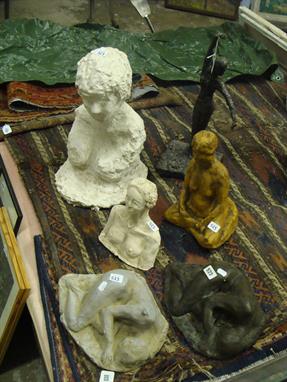We found 67799 price guide item(s) matching your search
There are 67799 lots that match your search criteria. Subscribe now to get instant access to the full price guide service.
Click here to subscribe- List
- Grid
-
67799 item(s)/page
Double-Signed, Possibly by the Artist Polycrates. Ex Bunbury 1896. Ex Perkins 1902. Ex Boston 1955 Bruttium. Terina. 410-405 BC. Stater, 7.16g (5h). Obv: Head of nymph Terina right, hair in sphendone decorated with meander pattern, wearing necklace; artist`s signature Π behind. Rx: Nike seated left with open wings on cippus, wearing chiton and himation; holding olive branch in right hand and resting left hand on cippus; artist`s signature Π on cippus. Holloway & Jenkins 47. Regling 43 (this coin). Boston MFA 1955, 213 (this coin). HN Italy 2602. EF Ex The New York Sale, Prospero Collection, 4 January 2012, lot 112. Ex M&M 54, 26 October 1978, lot 79. Ex Museum of Fine Arts Boston. Ex Sir E. Bunbury Collection, Sotheby 1896, lot 246. Ex Catherine Page Perkins Collection Literature: Guide to the Catherine Page Perkins Collection of Greek and Roman Coins, Boston 1902, #35 (this coin) Terina, Kurt Regling, #43d (this coin), Berlin 1906 Catalogue of Greek Coins, Agnes Baldwin Brett, Boston 1955, #213 (this coin) From the preface of the 1902 MFA Boston Perkins Guide: "As evidence of the estimation in which certain of them are held by connoisseurs, it may be of interest to state that one coin now in this collection was sold at a London auction a few years ago for over $1500, and another, at a different sale, brought over $900. Figures like these show that the formation of a collection of first-rate Greek coins is no longer a simple or inexpensive matter" (Edward Robinson, Director of the Museum) From the Introduction of the 1902 MFA Boston Perkins Guide: "No, 35, Terina (Pl. I), recalling the style of the Nike Balustrade (see casts, Nos. 491-497); and No. 28 Croton (Pl. I), which seems to reproduce the `Theseus` of the Parthenon (cast 410 C)." From the text of the 1902 MFA Boston Perkins Guide: "34-35 Terina, colonized from Croton 35 (Pl. I.) Nike (Victory) seated, holding an olive spray. This graceful and beautiful figure is among the finest creations of Greek coin-engraving. It is probably the work of the artist of the Pandosia stater, No. 32 (Pl. I). Compare the gem-like fineness of this coin with the similar but more sculpturesque and broadly treated coin of Elis, No. 355" The seated Nike is one of the most charming coin images from the late fifth century. Obviously the engraver Π "who clearly shows a sculptural tendency" (Jongkees) was well informed about avant-garde works of art. The informal, nonchalant posture of the goddess, the slightly rippling folds of her garments, all this shows features of the `rich style` developed by Attic sculptors after the Parthenon sculptures had been finished in 432 BC. The closest parallels can be found among the reliefs of the Nike temple parapet, the famous one showing Nike fixing her sandal in particular. Known as the `ornate style` in South Italian vase-painting, the `rich style` was not confined to sculptures, but it barely has parallels among Greek coins. Here is one of the rare examples where a talented coin engraver was stimulated by the most innovative artists of the Attic school in other media. Of the 605 coins in the Perkins collection that Boston purchased in three sections in 1895,1897 and 1900 only 57 were illustrated in the plates. That is less than 10% and our Terina was one of them. This coin left the museum, not in the 1980 sale of Boston duplicates held by NFA but by private treaty. It was sold to Herbert Cahn of M&M Basel before 1978. Cahn was one of the most renowned numismatists of the last century who was known for his scholarship and great eye. Further attesting to the importance of this coin are the comments, already cited, by the probable author of the Perkins guide, Jacob Hirsch of Ars Classica fame, who anonymously wrote the de Sartiges catalogue in France in 1910, spoke perfect English and thus probably wrote the Perkins Guide. A coin of this artistic quality combined with rarity, condition and provenance rarely comes into the market. Only 14 coins are recorded by Regling for this unique reverse die. It is very unusual that a signed coin or any coin can be linked to a famous sculpture group and further to a famous sculpture. It seems likely that these dies were created by Polycrates who was the author of the Acragas decadrachm dies which date to around the same time
Two Magnificent Tetradrachms of Mithradates the Great Pontic Kingdom. Mithradates VI. 120-63 BC. Tetradrachm, 16.84g (11h). , Year 213=85/4 BC. Obv: Diademed head of Mithradates right. Rx: Stag grazing left; ΒΑΣΙΛΕΩΣ above, star, crescent and monogram to left, date ΓΙΣ (year 213) and monogram to right, ΜΙΘΡΑΔΑΤΟΥ / ΕΥΠΑΤΟPΟΣ / A below; all within ivy wreath. De Callataÿ, p. 16, D5/R4 (this coin listed as specimen f). Hunter 3 (same dies). BMC 6. SNG Cop. 236. Dewing 2122. Iridescent toning. Mint State Ex Richard P. Miller Collection. Ex Triton V, 15 January 2002, lot 1399. Ex William N. Rudman Collection. Ex Edward J. Waddell Fixed Price List #68, 1996, lot 55. Ex Lanz 74, 20 November 1995, lot 190. Ex Busso Peus 326, 1-3 November 1989, lot 164. Ex Busso Peus 323, 1-4 November 1988, lot 790 An exceptional example; described by the collector as "a masterpiece of coin sculpture… beyond grading… overall the most beautiful coin I own"
[Roman Coins]. American Numismatic Society [publisher]. NUMISMATIC NOTES AND MONOGRAPHS ON ROMAN COINS. Seven titles: Philip V. Hill’s 1949 “Barbarous Radiates”: Imitations of Third-Century Roman Coins; Michael Grant’s 1950 Aspects of the Principate of Tiberius; Annalina Caló Levi’s 1952 Barbarians on Roman Imperial Coins and Sculpture; C.M. Kraay’s 1956 The Aes Coinage of Galba; Aline Abaecherli Boyce’s 1965 Festal and Dated Coins of the Roman Empire: Four Papers; David W. Mac Dowall’s 1979 The Western Coinages of Nero; and William E. Metcalf’s 1996 The Silver Coinage of Cappadocia, Vespasian–Commodus. All 8vo, all but first in original bindings (first bound in brown cloth). Generally fine. Numismatic Notes and Monographs, Nos. 112, 116, 123, 133, 153, 161 and 166.
Three sculptures, two of carved wood by DICK ONIANS (b. 1940) one mahogany of spherical faceted spiral form, the other of pine, carved into three spheres with draped form, both with signature to rectangular wooden base, together with IVOR LIVI. A Stainless steel sculpture of abstract geometric form, on domed base, unsigned. (3) approx. 40cm high, approx. 28cm high and approx. 24cm high. Provenance: Purchased from Century Galleries, Henley-on-Thames.
Chiqui DIAZ (né en 1967) Petite lionne Sculpture-volume modulaire en bronze. Reposant sur une base en bois Signée et numérotée 16/30 23 x 50 x 23 cm Les oeuvres de Chiqui DIAZ uniquement animalières sont le fruit d`une observation très approfondie de son sujet allant parfois jusqu`à la dissection pour rendre parfaitement l`anatomie de l`animal. Dans cette recherche il rejoint le mouvement artistique “néoprimitivisme” dont il est membre actif. Ses sculptures vont du petit modèle au gigantesque. Elles appartiennent aussi bien à des collections privées que publiques.
Manuel DONATO DIEZ (né en 1957) Flûtiste Sculpture en bronze numérotée 6/8 Fondeur Strassacker H : 30 cm Sculpteur reconnu en Allemagne pays où ce natif de Madrid vit et travaille depuis les années 1970 Manuel Donato DIEZ est devenu membre actif de plusieurs sociétés artistiques françaises. Il préside notamment la section Sculpture de la Société Nationale des Beaux-Arts (SNBA) depuis 2012. Très recherchés par les collectionneurs fortunés outre-Rhin ses bronzes impressionnent par leur maîtrise technique et dégagent une atmosphère de spiritualité et de puissance.
Chiqui DIAZ (né en 1967) Coccinelle sur une aile ou Coccinelle en vol. Sculpture-volume en bronze. Signée et numérotée 12/20 62 x 41 x 29 cm Les oeuvres de Chiqui DIAZ uniquement animalières sont le fruit d`une observation très approfondie de son sujet allant parfois jusqu`à la dissection pour rendre parfaitement l`anatomie de l`animal. Dans cette recherche il rejoint le mouvement artistique “néoprimitivisme” dont il est membre actif. Ses sculptures vont du petit modèle au gigantesque. Elles appartiennent aussi bien à des collections privées que publiques.
LE CORBUSIER (CHARLES-EDOUARD JEANNERET DIT) (1887-1965) Ozon Opus I 1947 Bois polychrome Aulne Sculptée par Joseph SAVINA Signée LC.JS Datée 47 Numérotée 2/5 0 74 x 0 47 x 0 38 m Provenance : Descendance directe de Joseph Savina Bibliographie : Le Corbusier et la Bretagne Roger Aujame p.63 (reproduite) Le Corbusier Savina Sculptures et Dessins Fondation Le Corbusier p.31 (reproduite) Joseph Savina l`Art et le Métier Pascal Aumasson Les presses de l`Atelier Municipal Saint Brieux 4ème trimestre 1988 p.37 (reproduite) Joseph Savina (1901-1983) avait appris le métier de menuisier de son père il s‚était ensuite aguerri à la sculpture sur bois dans l‚atelier de Jean-Marie Picard à Tréguier où il s‚installa en 1929 à l‚enseigne de « l‚art celtique » exprimant ainsi son intérêt pour les motifs irlandais récemment introduits en Bretagne. La même année il rejoignit l‚Unvaniez ar Seiz Breur groupe d‚artistes et d‚artisans désireux de relever les arts décoratifs bretons. Vite remarqué il se lia d‚amitié avec le poète et critique d‚art Pierre Guéguen (1889-1965) proche de Le Corbusier qui les fit se rencontrer en 1935 à l‚occasion de brèves vacances prises par l‚architecte dans le Trégor. L‚année suivante lors d‚un second séjour Le Corbusier encouragea Savina à infléchir sa production et lui laissa quelques croquis de meubles qu‚il mit illico à profit. Durant la guerre il lui demanda en outre de contribuer à son ravitaillement et lui offrit en remerciement l‚ouvrage consacré à ses dessins et à sa peinture publié en 1938. Savina eut alors l‚idée d‚en tirer des sculptures qu‚il montra timidement à Guéguen en 1944. Impressionné ce dernier lui conseilla d‚en envoyer des photos à Le Corbusier qui en fut immédiatement conquis. Dès lors débuta une collaboration féconde : le Corbusier envoyait des dessins à Savina qui dans son atelier de Tréguier les interprétait et les matérialisait. Ce premier travail était généralement peaufiné conjointement chez l‚architecte rue Nungesser et Coli et souvent polychromé. Quarante-quatre sculptures en provinrent parfois réalisées à plusieurs exemplaires portant la signature double « LCˆJS » ou « JSˆLC ». Ozon 1 du nom du village pyrénéen où Le Corbusier s‚était replié en 1940 est datée de 1947. Savina donna en outre un ˛uvre personnel et fut à l‚occasion le praticien d‚Henri Laurens que Gueguen lui avait également présenté. Daniel Le Couedic Architecte DPLG Docteur ès Lettres et Sciences Humaines Chercheur associé au Centre de recherche bretonne et celtique Professeur des Universités (Université de Bretagne) Directeur de l‚Institut de Géoarchitecture. Auteur de « Joseph Savina l‚improbable compagnon de route » in « Le Corbusier : l‚oeuvre plastique » Paris Fondation Le Corbusier Editions de la Villette 2005 p. 26-53
-
67799 item(s)/page



























![[Roman Coins]. American Numismatic Society [publisher]. NUMISMATIC NOTES AND MONOGRAPHS ON ROMAN COINS. Seven titles: Philip](http://lot-images.atgmedia.com/SR/35818/2891609/1412-2013121316267_468x382.jpg)































